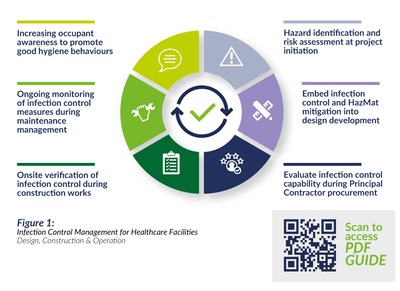Managing infection risks during construction, renovation and maintenance activities in healthcare facilities

Nosocomial infections are a serious risk to patients, especially those with haematological malignancies and who are immunosuppressed, which includes the elderly and the very young, patients receiving dialysis, patients taking immunosuppressive medications (including steroids) and oncology patients receiving chemotherapy.
Construction, renovation and maintenance activities are an ever-present reality of healthcare facilities and, without correct management, can disperse dust particles contaminated with bacteria and fungi. The connection between hospital construction works and healthcare-associated invasive aspergillosis is well recognised, with a significant body of evidence estimating that hospital construction or renovation activities account for approximately 50% of the sources of healthcare-associated Aspergillus outbreaks.
Aspergillosis is acquired primarily by inhalation of fungal spores and can lead to pneumonia. The fungus can also disseminate through the bloodstream to impact deep organs. Legionnaire’s disease is acquired through potable water contamination, which can occur when construction activities shut down or depressurise water supplies, allowing bacterial growth in the system. Multiple studies place mortality rates for healthcare-associated aspergillosis at between 65–100%, and 24–80% for Legionnaires’ disease, even after diagnosis and treatment of these infections.
In addition to the risks of infection, other common construction hazards, such as exposure to inhalable/respirable dust and asbestos fibres, can also pose an elevated risk within healthcare settings given the increased vulnerability of many of the occupants of these facilities.
Integrating infection control into design and construction
Early planning and integration of infection prevention and control strategies is critical in facility design, construction, renovation and maintenance projects to prevent infections, minimise allergen loading and effectively control other workplace hazards related to hazardous materials.
The management and control of hazardous materials during construction-related activities is well defined within Australian model WHS legislation and is an established consideration for any appropriately managed construction or maintenance project. However, follow-on infection risks remain for patients, visitors and staff, primarily associated with dispersion of dust potentially contaminated with bacteria and fungi. Multiple international standards and procedures provide guidance and processes to address these serious infection and health risks. Within the Australian legislative framework, there exists state-specific mandatory infection prevention and control procedures to inform the undertaking of healthcare-related construction, renovation and maintenance activities.
Assessing infection control and hazardous materials risks to healthcare facility occupants, and preventing and detecting fungal and bacterial infections, requires a multidisciplinary team (MDT) approach. The MDT should leverage the knowledge and skill sets of hospital staff, architects, engineers, infection control staff (doctors and nurses), contractors, facilities managers, infection control professionals and occupational hygienists to:
- improve understanding of the issues and identify responsibilities;
- implement suitable avenues of communication between responsible parties;
- plan and implement measures to mitigate risks;
- follow precautionary measures during construction-related activities to reduce infection risks. Precautionary measures should consider the type of construction, renovation or maintenance work, and proximity of such work to occupants.
Achieving effective infection control begins at the outset of a building’s design, via consideration of principals such as promotion of physical distancing, elimination of high touch points and creation of a hygienically controlled indoor environment.
The role of occupational hygienists and infection control professionals during planning, procurement and completion of healthcare-related construction is critical to identify and assess infection risks. This enables the design and construction process to be enhanced by developing, implementing and monitoring appropriate control measures. Figure 1 outlines the infection control considerations that an MDT should embed at relevant stages of a healthcare facility’s lifecycle.
While the association between construction activities and nosocomial infection is now well recognised and understood, there are significant opportunities to further embed holistic infection control into the design, construction and maintenance of Australian healthcare facilities. By embedding the knowledge and expertise of occupational hygienists and infection control professionals into collaborative MDTs for any healthcare-related construction or maintenance work, infection control risks can be proactively addressed and mitigated.
Fundamental reimagining: new Sydney Children's Hospital, Randwick
The new Sydney Children's Hospital, Randwick, was designed as a fundamental reimagining of...
UNSW Health Translation Hub opens
The $600 million UNSW Health Translation Hub — an integrated medical, research and health...
Vertical healing: redefining health care through high-rise hospital design
The high-rise hospital signifies more than a shift in form — it reflects a transformation...





![[New Zealand] Transform from Security Awareness to a Security Culture: A Vital Shift for SMB Healthcare — Webinar](https://d1v1e13ebw3o15.cloudfront.net/data/89856/wfmedia_thumb/..jpg)
![[Australia] Transform from Security Awareness to a Security Culture: A Vital Shift for SMB Healthcare — Webinar](https://d1v1e13ebw3o15.cloudfront.net/data/89855/wfmedia_thumb/..jpg)




